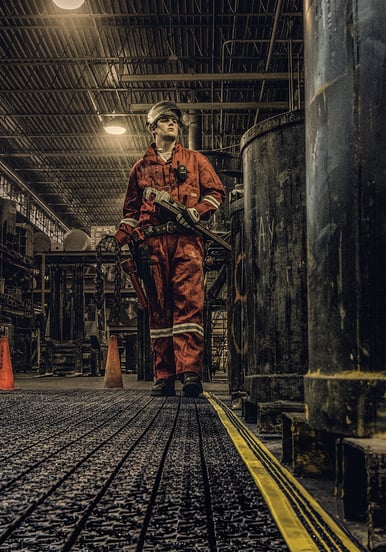In industrial locations, runner mats are often installed in work areas and these are required to have a bright yellow border. The Occupational Safety and Health Administration (OSHA) makes this compulsory, and it is designed to remind building users to take caution when walking through the facility. There may be physical hazards present that could cause someone to fall, stumble, or trip.
 It also reminds us that floor safety, especially in an industrial setting, does not have one solution. There is no 100 percent slip-resistant environment. This means industrial facility administrators must consider a variety of solutions to protect their workers. This would include slip-resistant shoes, industrial mats, safety training, and worker awareness. These all play a significant role in reducing hazards and preventing accidents.
It also reminds us that floor safety, especially in an industrial setting, does not have one solution. There is no 100 percent slip-resistant environment. This means industrial facility administrators must consider a variety of solutions to protect their workers. This would include slip-resistant shoes, industrial mats, safety training, and worker awareness. These all play a significant role in reducing hazards and preventing accidents.
However, because mats are so important to floor safety in these work environments, there are some very specific guidelines we need to know.
First, all key entries into an industrial facility should have as much as 15 feet of "high-performing" matting installed.
Some locations, especially those that rent entry mats, install a 3-foot-by-5-foot floor mat at building entries. This is far too small to collect and trap outdoor moisture, dust, soil, and other contaminants so they are not walked inside. Further, unlike purchased, high-performing mats, which are designed to collect and hold as much as 70 percent of all moisture and contaminants, rental mats tend to be lower quality, limiting their overall effectiveness considerably.
Spills are also a concern in most industrial locations. This is why many industrial locations install drainage mats for their workers. A drainage mat has specially designed holes in it that allow drips, grease, oil, drinks, and other types of spills, as well as small debris, to fall below the mat's surface, helping to keep the walking area safe, dry, and clean. Some of these mats even have anti-fatigue properties. This helps reduce worker fatigue, aches, and pains. Reducing pain and fatigue also helps promote worker safety.
In more extreme cases and in very harsh working environments, an Ergo-Xtreme mat can hold up well to both moisture and oily conditions should be considered. Often these are modular designed mats, allowing administrators and workers to arrange them as necessary to address specific environmental challenges.
Along with spills, some industrial locations work with chemicals that might damage floor mats. In such cases, it is always best to consult with an astute distributor or contact a floor mat manufacturer when this is the case. However, the type of mat that typically can hold up best in such situations is a mat made of molded nitrile, a synthetic rubber.
Finally, in some cases, the borders of mats can fold, potentially becoming a trip hazard themselves. This is why administrators should also consider selecting mats that are beveled, offering one more solution to help prevent slips and falls in industrial locations.
For more information on the many types of mats and how to select the best mats for your facility, contact Crown Matting Technologies at 800-628-5463 or send us an email.
Comments